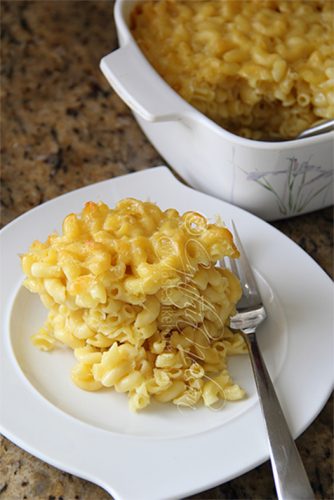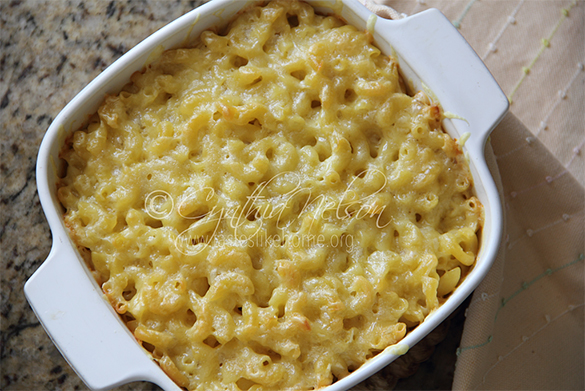
Here in Guyana and the entire Caribbean, there are many stories to be told of the origins of our foodways. Some origins and influences are obvious; however, I am always more excited about the creations that come from our own ingenuity and resilience; the uniqueness of tastes and flavours that we draw from a plethora of ingredients, herbs, spices, and techniques that we can say, “Is We Own”.

One of the most popular, well-loved and signature dishes in the Caribbean is Macaroni Pie, some say Macaroni and Cheese, Mac Pie or in a distinct Bajan accent – Poi (pronounced poy). Ask some citizens around the region and they will tell you it’s their national dish, that my friends is the importance of Macaroni Pie to this region. Each country has its own version and way of making this casserole dish of pasta and cheese, with milk being the other main ingredient. The signature Macaroni Pie could be based on the shape of the pasta used – bucatini (the long pasta with the hollow middle), elbows, shells, or penne. The texture is another distinguishing feature – dense and claggy where it can be cut into neat, tidy blocks or loose and thickly creamy. And then there is the appearance of the pie – crunchy (bread or biscuit crumbs topping), creamy or crusty (melted cheese topping). The casserole dish is equally important – many of us grew up seeing Macaroni Pie baked in a dedicated ceramic casserole dish, perhaps with the brand name Pyrex. Then of course there is the glass baking dish – round, square or oblong in shape. It goes without saying that the pie from each country will also carry its unique, yummy flavour based on other ingredients added to the pie – herbs, spices, vegetables, cheese(s) and butter or margarine. For example, here in Barbados, Macaroni Pie is not what it should be without that signature flavour and deep orange colour of Roberts’ mello-kreem margarine. A little bit of ketchup and mustard also helps boost the flavour and colour.
My Macaroni Pie is influenced by how my mom made hers – a béchamel sauce that starts with a roux of equal amounts of butter and flour to which milk is added and seasoned with salt, pepper and grated nutmeg, the cheese is added once the sauce is thickened enough turning the mixture into a Mornay sauce. The cooked pasta is tossed with the Mornay sauce, topped with grated cheese, and baked until bubbly and golden.
It’s hard to trace the origin story for our making of Macaroni Pie in the Caribbean, there are a couple of tributaries from which it could have come from, but it is most likely from somewhere in Europe. Here in Barbados, they talk of their general love of pasta and Macaroni Pie because of the pasta-making company that was here a long time ago – Catelli. The company still has a presence on the island, but the manufacturing is done elsewhere.
Episode 3 of the Netflix documentary series I mentioned at the top of the column, turns the spotlight on two of the most lauded epicureans of the 18th and 19th centuries: Hercules Posey, head chef for George Washington and James Hemmings, head chef for Thomas Jefferson. Both men were enslaved while they worked for these presidents. When Jefferson was appointed foreign minister to France, he took 19-year-old Hemmings with him and that is where Hemmings learned to cook professionally. Upon their return to the United States, Hemmings helped popularize certain foods in America – French fries, ice cream and Macaroni Pie.
The recipe featured on the episode got me excited because of the sheer simplicity of it and the use of a technique which the host and a culinary historian on the show say they now use when they make Macaroni Pie. At two hundred years old, it’s almost not a recipe but a technique, a way of making Macaroni Pie.
The pasta – elbows – are cooked until tender (not al dente) in a mixture of equal parts water and milk. The use of milk helps tenderize the pasta and give it a sort of silky texture.
The cooked, drained pasta is then layered in a casserole dish along with pats of butter, followed by grated cheese. The process/layering is repeated until all the pasta is used up; covered and baked until everything is heated through, and the cheese melted and clinging to the pasta. That’s it. It made me think of how often we can complicate things but at the same time, it is important to trouble some things to have new creations.
Earlier this week I made the pie just as they did on the show. The baked pie had the look of Macaroni Pie and all the flavour that one expects from Macaroni Pie. You taste the butter, the cheese, and the pasta itself. Sometimes when eating Macaroni Pie, it seems to be all about the other things added to the pie rather than the pasta enriched by the sauce.
This recipe I found to be a light Macaroni Pie, if we could ever think of this dish as being light (lol). Honestly though, it is not heavy, nor is it overly rich as the pies we are accustomed to, and yet, it has all the flavour we would want in a Macaroni Pie. I’d like you to give the recipe a try and let me know what you think. It’s not our own but at least we can taste and understand a part of its origin.
Cynthia
An Old Recipe for Macaroni Pie
Yield: 8 x 8” pie casserole dish
INGREDIENTS
• Tap water
• Whole milk
• Salt to taste
• 1-pound dry pasta (shape of your choice)
• Butter – salted or unsalted
• Grated cheese (sharp cheddar or of your choice)
DIRECTIONS
1. Preheat oven to 350 degrees F.
2. Brush the baking dish with butter or oil and set aside.
3. Bring a pot of equal parts water and milk to boil in a large pot. When the pot comes to a boil add salt to taste. Be sure to use a large enough pot because the milk will cause the mixture to rise as it boils.
4. Add the pasta and stir well. Cook until tender, fully cooked, but not breaking apart. Drain well.
5. Add a layer of pasta at the bottom of the dish, dot with pats of butter and then sprinkle an even layer of cheese. Repeat the layering – pasta, butter, and cheese until all the pasta is used up. The last layer should be of cheese.
6. Transfer to the oven and bake for 25 – 30 minutes or until the cheese is melted and the top lightly golden. Let cool for 20 minutes and then spoon and serve.
NOTES
• Instead of layering with butter, I tossed the hot drained pasta with butter so that it could be distributed evenly and be absorbed into the pasta. Therefore, my layers became – pasta and cheese, alternating.
• If you like, add a few pats of butter when the dish comes out of the oven.
• The original recipe used only 1 type of cheese, but you can use a mixture of cheeses






